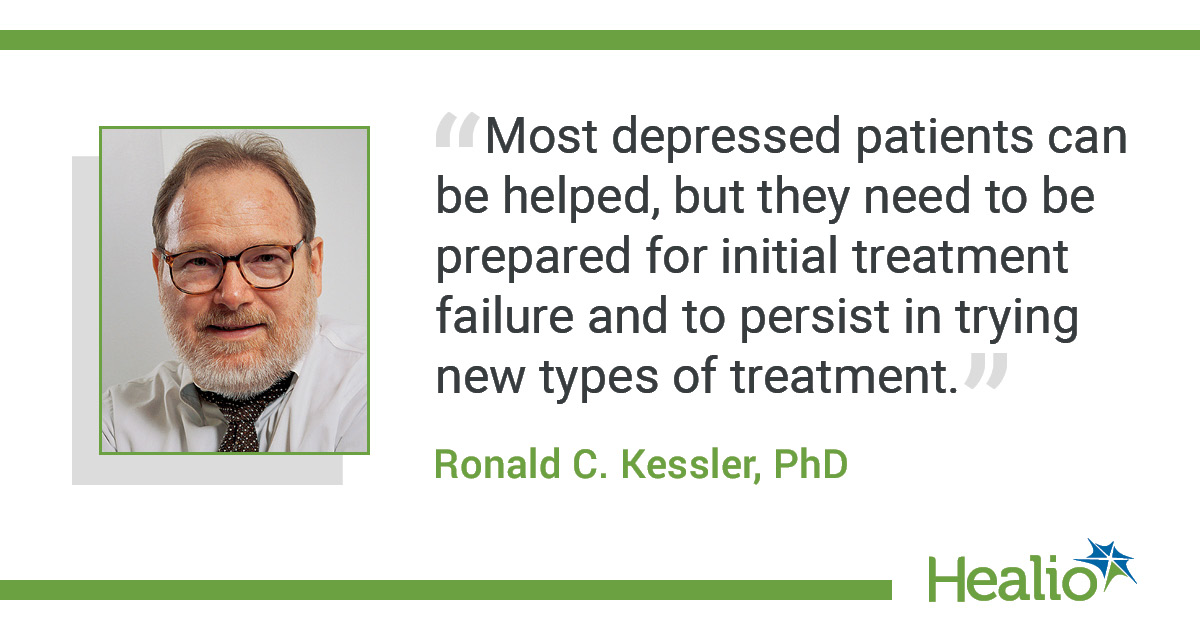‘Trial and error’ treatment approach for major depressive disorder has pros and cons, experts say
Patients with major depressive disorder were more likely to receive effective treatment if they persisted beyond early unhelpful treatment, according to results of a survey study published in JAMA Psychiatry.
“We have known for quite some time that people who receive treatment for mental disorders often stop one kind of treatment and then start another, presumably searching for help that they did not receive from the first treatment provider,” Ronald C. Kessler, PhD, of the department of health care policy at Harvard Medical School, told Healio Psychiatry. “We wanted to know how long it took typical patients to find helpful treatment and how often patients never found helpful treatment.”
Prior studies of depression treatment helpfulness evaluated short-term treatment among prevalent cases, which has left a longer-term perspective missing from the literature. Specifically, this limited focus excludes the many incident MDD cases in which patients take longer than 1 year to initiate treatment and thus provides only one aspect of the long-term MDD course across the complete treatment pathway, according to the investigators.
Kessler and colleagues aimed to examine the factors and prevalence linked to the two main components of perceived treatment helpfulness among a representative sample of individuals with a lifetime history of DSM-4 MDD. They analyzed the results of a coordinated series of community epidemiologic surveys of noninstitutionalized adults using 17 WHO World Mental Health surveys, of which eight were conducted in high-income countries and nine in low- and middle-income countries.

Kessler and colleagues included individuals with a lifetime history of treated MDD and collected data on socioeconomic characteristics, lifetime comorbid conditions including anxiety and substance use disorders, treatment type, treatment timing and country income level. Data collection periods ranged from 2002 to 2003 to 2016 to 2017.
Main outcomes and measures included conditional probabilities of helpful treatment after seeing between one and five professionals, persistence in help-seeking after between one and four unhelpful treatments, and ever obtaining helpful treatment regardless of professionals seen.
Results showed a range of survey response rates, from 50.4% in Poland to 97.2% in Colombia. Across surveys, the pooled response rate was 68.3% (n = 117,616). First depression treatment mean age was 34.8 years, and 69.4% of participants were women. Among 2,726 individuals with a lifetime history of MDD treatment, the cumulative probability pooled across countries of all respondents receiving helpful treatment after seeing up to 10 professionals was 93.9%; however, only 21.5% of patients persisted beyond nine unhelpful treatments, which resulted in 68.2% of patients ever receiving treatment they perceived as helpful. Kessler and colleagues reported four factors associated with an increased probability of perceiving treatment as helpful — older age at treatment initiation (adjusted OR [aOR] = 1.02; 95% CI, 1.01-1.03), higher educational level (low: aOR = 0.48; 95% CI, 0.33-0.7; low-average: aOR = 0.62; 95% CI, 0.44-0.89; high-average: aOR = 0.67; 95% CI, 0.49-0.91 vs. high educational level), shorter delay in treatment initiation after first onset (aOR = 0.98; 95% CI, 0.97-0.99) and medication received from a mental health specialist (aOR = 2.91; 95% CI, 2.04-4.15). According to decomposition analysis, older age at treatment initiation and higher educational level were associated with only the conditional probability of an individual treatment professional having been perceived as helpful. Shorter delay in treatment initiation after first onset and medication received from a mental health specialist were associated with only persistence (treatment delay: aOR = 0.98; 95% CI, 0.97-0.99; treatment type: aOR = 3.43; 95% CI, 2.51-4.7).
“Most depressed patients can be helped, but they need to be prepared for initial treatment failure and to persist in trying new types of treatment until they find one that works,” Kessler told Healio Psychiatry.
In a related editorial, Mario Maj, MD, PhD, of the department of psychiatry at University of Campania Luigi Vanvitelli in Italy, highlighted some of the shortcomings of the current study.
“Treatment of depression may well be ‘a trial and error enterprise,’ as [Kessler and colleagues] emphasize,” Maj wrote. “However, the likelihood that it is perceived as helpful will increase if we make clear that the qualification of the treatment professional, a formulation of the management plan based on the characteristics of the individual patient, and adequate attention to the therapeutic alliance and to the patient’s desired outcomes are among the main factors involved. Professionals and treatments are not all interchangeable, and generically encouraging patients to ‘persist in help-seeking after earlier treatments have failed’ may be misleading, and reinforce the tendency of many patients to leave the physician or psychologist they have consulted just because the first treatment attempt has failed.” – by Joe Gramigna
Disclosures: Kessler reports grants from Sanofi-Aventis, as well as personal fees from Datastat Inc, Johnson & Johnson Services Inc Lake Nona Life Project, Johnson & Johnson Wellness and Prevention, Sage Therapeutics, Shire and Takeda outside the submitted work. Please see the study for all other authors' relevant financial disclosures. Maj reports no relevant financial disclosures.
